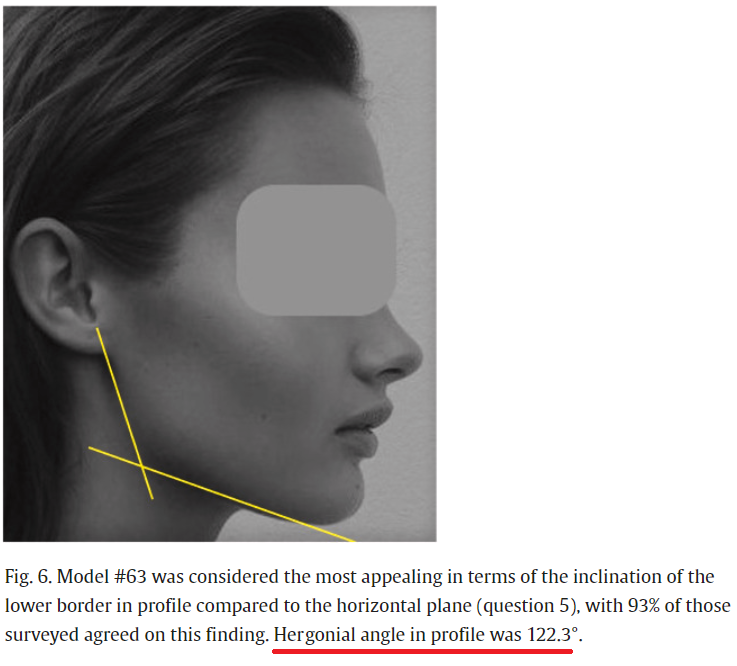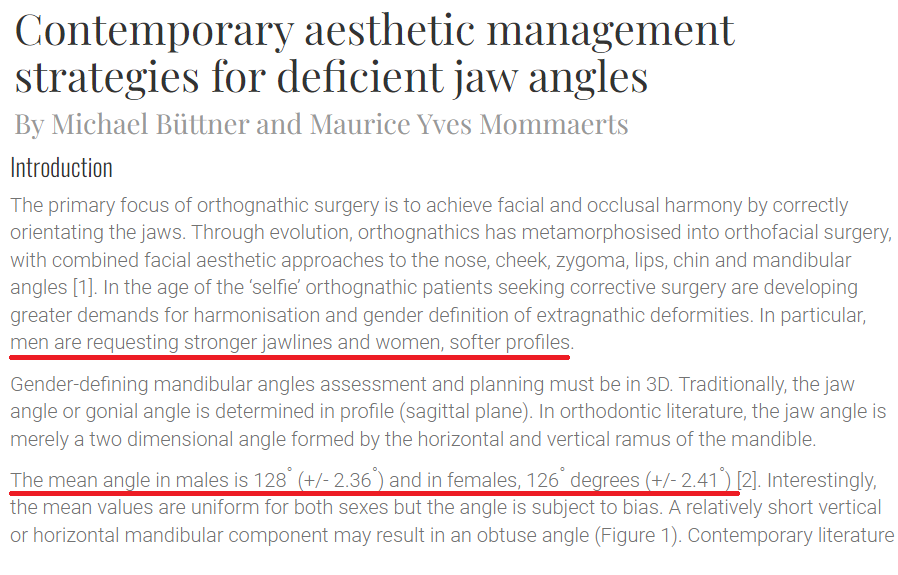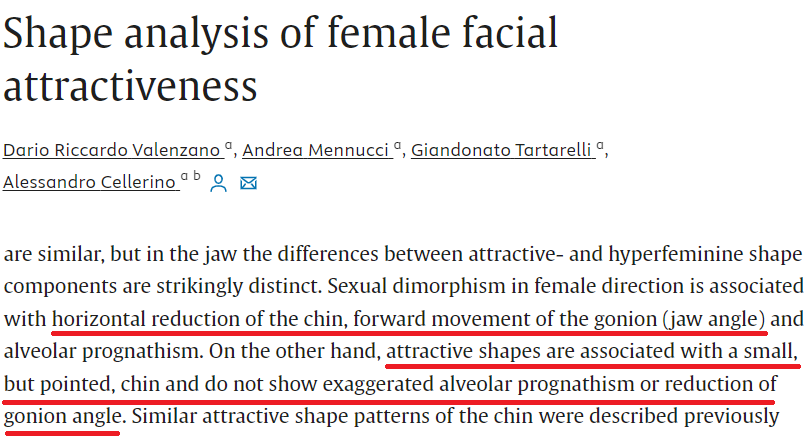Summary
The jaw angle, also known as the gonial or mandibular angle, is where the lower jawbone meets the back edge of the jaw’s vertical part. A study by Mommaerts and Claymaet (2023) identified Model #63, with a jaw angle of 122.3°, as the most attractive for white females, with the average attractive jaw angle being 125.5°. Another study by Büttner and Mommaerts (2015) found that women prefer softer jaw profiles, aligning with a mean female jaw angle of 126°. Moradinejad et al. (2022) also noted the average female jaw angle as approximately 126°±2.41°, suggesting that narrower jaw angles are generally more desirable. Valenzano et al. (2006) indicated that attractive female jaw shapes feature a small, pointed chin without exaggerated traits like alveolar prognathism or a reduced gonion angle, emphasizing that a moderate jaw angle enhances perceived attractiveness.
Research
According to Jensen and Palling (1954) the jaw angle, also known as the gonial angle or mandibular angle, is the point where the bottom edge of the lower jawbone meets the posterior border of the ramus (i.e., back edge of the vertical part of the jaw).
A research study carried out by Mommaerts and Claymaet (2023) titled “The ideal shape of the female jaw angle: An online survey” intended to determine the characteristics of an attractive white female jaw angle. As per this study, Model #63 was considered the most appealing having jaw angle of 122.3°. Likewise, the mean jaw angle in profile for attractive women was 125.5°.

Another study by Büttner and Mommaerts (2015) highlights that “men are requesting stronger jawlines and women, softer profiles” suggesting that females generally desire narrower jaw angles. This aligns with the perception that softer, less angular jawlines are considered more feminine and aesthetically pleasing for women. As per this study, the mean jaw angle in female is 126°.

Similarly, a study by Moradinejad et al. (2022) pointed out that the average jaw angle in females is approximately 126°±2.41°. Moreover, the study suggests that narrower jaw angles in females are often considered more desirable by orthodontists, oral and maxillofacial (OMF) surgeons, and the general public. This is because strong jaw angle is typically perceived as a masculine feature, thereby, having a sharper or a moderate jaw angle is better for female.

As far as a moderate jaw angle in females is considered, a study by Valenzano et al. (2006) highlights that while sexual dimorphism in the female direction involves a horizontal reduction of the chin and forward movement of the gonion, attractive jaw shapes are associated with a small, pointed chin and do not exhibit exaggerated features such as alveolar prognathism or a reduced gonion angle. This suggests that a moderate jaw angle, rather than an exaggeratedly narrow one, contributes to perceived attractiveness in females.

Reference
Jensen, E., & Palling, M. (1954). The gonial angle: A survey. American Journal of Orthodontics, 40(2), 120-133. https://doi.org/10.1016/0002-9416(54)90127-X
Mommaerts, M. Y., & Cleymaet, R. (2023). The ideal shape of the female jaw angle: An online survey. Journal of Cranio-Maxillofacial Surgery, 51(10), 597-602. https://doi.org/10.1016/j.jcms.2023.08.009
Büttner, M., & Mommaerts, M. Y. (2015). Contemporary aesthetic management strategies for deficient jaw angles. PMFA News, 2(4), 6-9. https://www.thepmfajournal.com/features/features/post/contemporary-aesthetic-management-strategies-for-deficient-jaw-angles
Moradinejad, M., Rekabi, A., Ashtiani, A. H., Atashkar, N., & Rakhshan, V. (2022). Psychometric and Perceptometric Comparisons of the Perspectives of Orthodontists, Oral and Maxillofacial Surgeons, and Laypeople of Different Ages and Sexes towards Beauty of Female Jaw Angles (Intergonial Widths and Gonial Heights) on Frontal and Three‐Quarter Views. BioMed Research International, 2022(1), 2595662. https://doi.org/10.1155/2022/2595662
Valenzano, D. R., Mennucci, A., Tartarelli, G., & Cellerino, A. (2006). Shape analysis of female facial attractiveness. Vision research, 46(8-9), 1282-1291. https://doi.org/10.1016/j.visres.2005.10.024